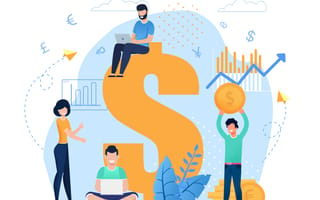
Sales leaders all over have worked tirelessly to structure their enablement strategies in order to best set up their teams for success.
Whether it’s customer-facing content, meetings on best practices or data gathered from software applications, the strategies need to be easy to consume and able to function across the entire sales organization. In 2021, the means to sales enablement aren’t changing entirely — but they are getting more effective.
For sales enablement leaders at three local companies, the evolution of enablement tools, and the frequency in which they’re used, will dominate the space in the next year (think: “micro” trainings and more automation). And for one local company, sales enablement may not be sales enablement for too much longer — “revenue enablement” will ensure more stakeholders are aligned.
Built In Chicago checked in with Russell Wurth, vice president of worldwide sales enablement at Showpad, Jenny Reinhard, director or sales enablement at Syndigo, and Beth Meadows, a sales enablement manager at Upwork, to learn more about the strategies their respective companies have found to be successful and the trends they’re focusing on for future success.
Showpad offers a flexible sales enablement platform that integrates training and software with content solutions in order to help users drive sales. Vice President of Worldwide Sales Enablement Russell Wurth said that today, sales enablement is about engaging customers by providing insights and guidance, and tailoring the message to each specific audience.
Why has sales enablement been a successful strategy within your organization?
Sales enablement is at the core of Showpad, both in the solutions we provide and in the engagement we deliver in the enablement community. As companies go through tremendous growth, enablement takes on a challenging role. It extends beyond onboarding sales into providing the framework for the ongoing development of knowledge and skills across the entire revenue organization. With growth comes new products, solutions, markets and verticals. These are the challenges that enablement professionals try to address every day by developing content, launching programs and measuring impact for continuous improvement.
The biggest trend we’re seeing in the space is the evolution of sales enablement into revenue enablement.”
How has your use of sales enablement strategies changed over time?
Selling today has advanced beyond pitching features and driving activity. It’s about engaging customers by providing insights and guidance, and tailoring the message to each specific audience. We are seeing enablement strategies align with sales managers who then can develop coaching abilities to improve the sellers’ knowledge and skills. The technology now exists to not only provide e-learning in unique and engaging ways but also to evaluate the performance in both exercise scenarios as well as live customer calls.
Enablement and content are tightly coupled. There cannot be any enablement and training programs without content, and any major marketing initiatives with new content kits will require enablement. Since the production of both content and enablement programs have a high cost, there is an expected impact they would have on sales performance, from generating new pipelines to conversion through the funnel and closing the deal in a timely and profitable manner. This attribution to impact is becoming the first question sales leaders are asking of their enablement teams.
Looking forward, what trends are you watching in the sales enablement space?
The biggest trend we’re seeing in the space is the evolution of sales enablement into revenue enablement. For B2B sales transactions, there are larger groups involved in the purchase decisions and again at the time of renewal or upsell. There are an average of nine people involved in a B2B purchase decision. The vendor likely has more than just salespeople that interact with the customer stakeholders through this process, including sales engineers, professional services and customer success professionals, among others. To deliver the best buyer experience, all of these roles need to be enabled with consistent and impactful content, message, tools and processes.
Syndigo is an online platform for companies in need of sharing product information between manufacturers, distributors, global retailers and recipients. Director of Sales Enablement Jenny Reinhard said that a constant stream of information, followed by inspection and reinforcement, has helped her team feel confident in their sales enablement methods and solutions.
Why has sales enablement been a successful strategy within your organization?
Syndigo is an incredibly fast-moving organization with a long-term acquisition strategy and ever-evolving service offerings. As a result, we must have strategic processes in place to keep everyone informed and up to speed professionally — all during a pandemic that has forced us into a remote-learning environment.
We’ve found unique ways to not only educate the sales team on products and services but also created a culture of the “forever learner.” Working together as a team has been paramount to our success, with strong communication channels and leaning on our resources to help us do this at scale.
With the fast-paced nature of our organization, long-form instruction and information sessions were an unrealistic approach to sales training and enablement. Therefore, we have adopted a short-form approach under the guise of ‘micro trainings’ that have proven to be highly effective in communicating the amount of information necessary to be successful. We’ve found that a constant stream of information followed by inspection and reinforcement has helped everyone feel confident in their solutions knowledge and sales methods.
The advancement of call recording analytics that highlight talk ratios and key terms will be extremely helpful in 2021.”
How has your use of sales enablement strategies changed over time?
A fully-remote environment demands a different schedule as well as more interaction to keep everyone present. Video calls and gamification have landed themselves as the tried-and-true methods of sharing information while also keeping everyone engaged in a time where it would be easy to get distracted. It has also become clear that full days of instruction without any real-world application led to low rates of knowledge retention.
Our team has shifted the onboarding schedule to a Monday-Wednesday-Friday approach that opens calendars for in-field instruction of what they are learning.
Another change that we made this year has been around prioritizing downtime. We realized that games like bingo or spot the difference give our employees a much needed and fun mental break.
Looking forward, what trends are you watching in the sales enablement space?
The main trend our team is focused on right now is the evolution of tools that can improve our sales velocity. It’s exciting to learn about different ways we can incorporate automation with our CRM to assist our guided-selling approach.
There are several software applications out there that help analyze the right talk tracks and content strategy our commercial team should be using. The advancement of call recording analytics that highlight talk ratios and key terms will be extremely helpful in 2021.
Analyzing calls is not new to sales but digging deep into the metadata that some of these tools can extract will help us become more strategic with our talk tracks, buyer personas and best practices. This type of data also lends itself to interdepartmental collaboration. Being able to provide accurate, analytical insights to our product, operations and marketing teams will help everyone stay true to Syndigo’s unparalleled white-glove service.
Upwork is the world’s largest work marketplace, connecting millions of businesses with independent talent around the globe. Sales Enablement Manager Beth Meadows said that Upwork has been able to use insights from data-driven tools to uplevel its customer touchpoints through better targeting and more relevant messaging.
Why has sales enablement been a successful strategy within your organization?
At Upwork, I credit the success of this function to three things: commitment to understanding our customers, the ability to move quickly and top-down support from leadership. This was a challenging year for sales teams across the board and Upwork was no exception to that. This year forced our customers to adapt — practically overnight — and brought about new selling scenarios for our sales team.
In April, we launched a COVID-19 sales playbook, which centralized real-time learnings from the sales floor. Through this digital resource, sales reps were able to quickly consume successful talk tracks and new use-cases from peers and into their own business immediately. At a time when everything was uncertain, we found our way through by centering on our customer and choosing progress over perfection.
There’s a huge opportunity in this new remote world for more self-paced enablement.”
How has your use of sales enablement strategies changed over time?
Upwork’s sales enablement program has been a constant evolution over the last few years. Initially, we needed to arm reps with the right tools like Gong.io, SalesLoft and Highspot to serve as a foundation for all customer touchpoints. Now, we are beginning to unlock the value that these data-driven platforms provide.
The ability to use insights from across the sales team has upleveled our customer touchpoints through better targeting and more relevant messaging. It’s empowered us to make business decisions on where to put additional focus for our teams, whether it be upskilling opportunities, content development or process improvements. Through this data, we were able to develop resources and training for specialized customer personas, which has helped our sales team draw connections between similar buyers and drive value more quickly.
Looking forward, what trends are you watching in the sales enablement space?
There’s a huge opportunity in this new remote world for more self-paced enablement that can happen outside of instructor-led (virtual or in-person) environments. I think we’ll start to see virtually-delivered micro-content (think two to five minutes), blended with facilitator-led training and coaching become the new standard to optimize retention and application. With this approach, lean enablement teams can more easily scale, while also ensuring that programs are aligned to the highest sales priorities and leveraged at exactly the right time.










